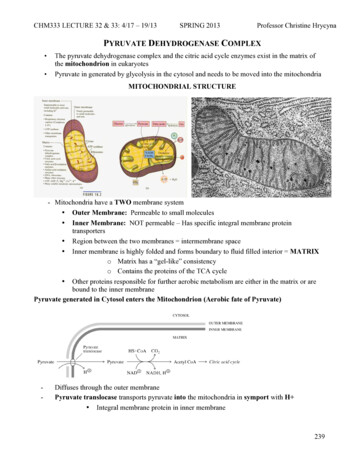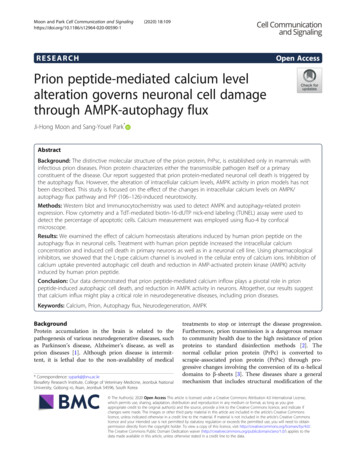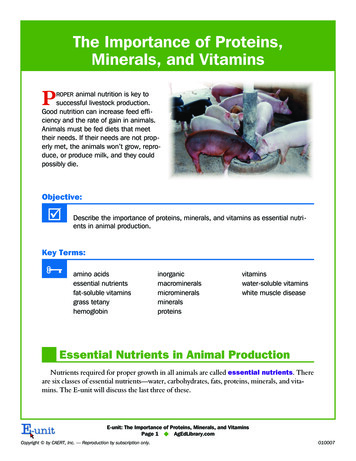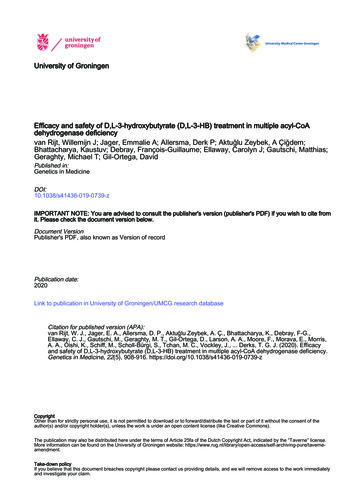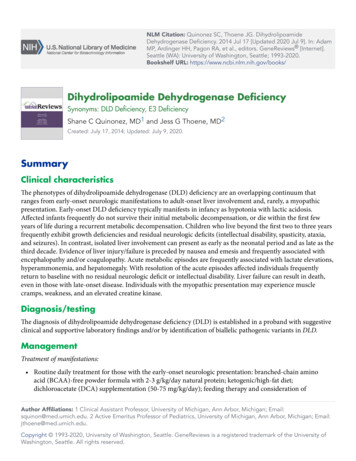
Transcription
NLM Citation: Quinonez SC, Thoene JG. DihydrolipoamideDehydrogenase Deficiency. 2014 Jul 17 [Updated 2020 Jul 9]. In: AdamMP, Ardinger HH, Pagon RA, et al., editors. GeneReviews [Internet].Seattle (WA): University of Washington, Seattle; 1993-2020.Bookshelf URL: e Dehydrogenase DeficiencySynonyms: DLD Deficiency, E3 DeficiencyShane C Quinonez, MD1 and Jess G Thoene, MD2Created: July 17, 2014; Updated: July 9, 2020.SummaryClinical characteristicsThe phenotypes of dihydrolipoamide dehydrogenase (DLD) deficiency are an overlapping continuum thatranges from early-onset neurologic manifestations to adult-onset liver involvement and, rarely, a myopathicpresentation. Early-onset DLD deficiency typically manifests in infancy as hypotonia with lactic acidosis.Affected infants frequently do not survive their initial metabolic decompensation, or die within the first fewyears of life during a recurrent metabolic decompensation. Children who live beyond the first two to three yearsfrequently exhibit growth deficiencies and residual neurologic deficits (intellectual disability, spasticity, ataxia,and seizures). In contrast, isolated liver involvement can present as early as the neonatal period and as late as thethird decade. Evidence of liver injury/failure is preceded by nausea and emesis and frequently associated withencephalopathy and/or coagulopathy. Acute metabolic episodes are frequently associated with lactate elevations,hyperammonemia, and hepatomegaly. With resolution of the acute episodes affected individuals frequentlyreturn to baseline with no residual neurologic deficit or intellectual disability. Liver failure can result in death,even in those with late-onset disease. Individuals with the myopathic presentation may experience musclecramps, weakness, and an elevated creatine kinase.Diagnosis/testingThe diagnosis of dihydrolipoamide dehydrogenase deficiency (DLD) is established in a proband with suggestiveclinical and supportive laboratory findings and/or by identification of biallelic pathogenic variants in DLD.ManagementTreatment of manifestations: Routine daily treatment for those with the early-onset neurologic presentation: branched-chain aminoacid (BCAA)-free powder formula with 2-3 g/kg/day natural protein; ketogenic/high-fat diet;dichloroacetate (DCA) supplementation (50-75 mg/kg/day); feeding therapy and consideration ofAuthor Affiliations: 1 Clinical Assistant Professor, University of Michigan, Ann Arbor, Michigan; Email:squinon@med.umich.edu. 2 Active Emeritus Professor of Pediatrics, University of Michigan, Ann Arbor, Michigan; Email:jthoene@med.umich.edu.Copyright 1993-2020, University of Washington, Seattle. GeneReviews is a registered trademark of the University ofWashington, Seattle. All rights reserved.
2GeneReviews gastrostomy tube for persistent feeding issues; standard treatment for developmental delay / intellectualdisability, cardiac dysfunction, and vision impairment / optic atrophy. Acute inpatient treatment for those with early-onset neurologic presentation: address any precipitatingfactors (infection, fasting, medications); D10 (half or full-normal saline) with age-appropriate electrolytes;consideration of bicarbonate therapy for those with severe metabolic acidosis; withholding of protein for amaximum of 24 hours; consideration of renal replacement therapyies; total protein intake 2-3.5 g/kg/dayas BCAA-free amino acids; isoleucine and valine supplements; maintain serum osmolality within thenormal reference range; levocarnitine (IV or PO) 50-100 mg/kg/day divided three times per day;continuation of DCA; standard therapy for seizures. For hepatic presentation: removal or treatment of precipitating factors; dextrose-containing IV fluids (6-8mg/kg/min) with age-appropriate electrolytes and/or frequent feedings; consider correction of metabolicacidosis using sodium bicarbonate; consideration of DCA and/or dialysis; consideration of fresh frozenplasma for coagulopathy. For the myopathic presentation: At least one affected individual with severe exercise intoleranceresponded well to riboflavin supplementation (220 mg/day).Prevention of primary manifestations: No compelling evidence exists for the prevention of acute episodes, despitemultiple attempted dietary strategies and medications. Provide protein intake at or around recommendeddietary allowance and titrate based on growth and plasma amino acid values; supplementation withlevocarnitine, if deficient.Prevention of secondary complications: DCA has been associated with the development of peripheral neuropathy;thus, individuals receiving this medication require close monitoring.Surveillance: Measurement of growth parameters and evaluation of nutritional status and safety of oral intake ateach visit; full amino acid profile (from plasma or filter paper) weekly or twice weekly in rapidly growing infantsand routinely in older individuals; at least monthly visit with a metabolic specialist in infancy; assessment ofdevelopmental milestones at each visit or as needed; physical examination and/or ultrasound to assess liver size,measurement of liver transaminases and liver synthetic function, and assessment for peripheral neuropathy ateach visit; echocardiogram at least annually or based on clinical status; ophthalmologic evaluation as clinicallyindicated.Agents/circumstances to avoid: Fasting, catabolic stressors, and extremes of dietary intake until dietary tolerance/stressors are identified; liver-toxic medications.Evaluation of relatives at risk: Testing of all at-risk sibs of any age is warranted to allow for early diagnosis andtreatment of DLD deficiency and to avoid risk factors that may precipitate an acute event. For at-risk newbornsibs when molecular genetic prenatal testing was not performed: in parallel with NBS either test for the familialDLD pathogenic variants or measure plasma lactate, plasma amino acids, and urine organic acids.Genetic counselingDLD deficiency is inherited in an autosomal recessive manner. At conception, each sib of an affected individualhas a 25% chance of being affected, a 50% chance of being an asymptomatic carrier, and a 25% chance of beingunaffected and not a carrier. Carrier testing for at-risk relatives and prenatal testing for pregnancies at increasedrisk are possible if the DLD pathogenic variants in the family are known.DiagnosisDihydrolipoamide dehydrogenase (DLD) functions as the E3 subunit of three mitochondrial enzyme complexes:branched-chain alpha-ketoacid dehydrogenase (BCKDH) complex, α-ketoglutarate dehydrogenase (αKGDH)complex, and pyruvate dehydrogenase (PDH) complex [Chuang et al 2013]. The E3 subunit is responsible for the
Dihydrolipoamide Dehydrogenase Deficiency3reoxidation of the reduced lipoyl moiety of the E2 subunit. Although DLD also functions as the L protein of theglycine cleavage system, pathogenic variants in DLD do not appear to impair the function of this system in vivo.The phenotypic spectrum of DLD deficiency includes an early-onset neurologic presentation, a primarily hepaticpresentation, and a primarily myopathic presentation.No formal clinical diagnostic criteria have been established for dihydrolipoamide dehydrogenase (DLD)deficiency.Suggestive FindingsThe diagnosis of dihydrolipoamide dehydrogenase (DLD) deficiency should be suspected in individuals withthe following clinical and supportive laboratory findings.Clinical findings Neurologic. Early-onset hypotonia, lethargy, and emesis In untreated infants, manifestations progress to deepening encephalopathy (lethargy, toneabnormalities, feeding difficulties, decreased level of alertness, and occasionally seizures) andeventual death. Neurologic impairment presents in those who survive the first year of life. Hepatic. Recurrent liver injury/failure frequently preceded by nausea and emesis Age of onset ranges from the neonatal period to the third decade. Individuals with the hepatic form typically have normal intellect with no residual neurologic deficitbetween acute metabolic episodes unless neurologic damage has occurred. Myopathic. Muscle cramps, weakness, and an elevated creatine kinaseWhile muscle involvement is the main feature in previously reported individuals, additional findingsinclude intermittent acidosis and hepatic involvement [Quintana et al 2010, Carrozzo et al 2014].Supportive laboratory findings Newborn screening (NBS). Citrulline is elevated on NBS dried blood spot [Haviv et al 2014, Quinonez etal 2014].Note: (1) Newborn screening has failed to identify asymptomatic individuals with DLD deficiency wheneither dried blood spot citrulline or leucine is used as a primary screening analyte; (2) Individuals with anearly-onset or hepatic presentation only occasionally have biochemical evidence of dysfunctionalbranched chain amino acid (BCAA) metabolism (i.e., elevations of allo-isoleucine and branched chainketoacids; see Table 1), making leucine an unreliable marker for screening; (3) DLD deficiency is not listedas a condition on the differential diagnosis for an increased citrulline on the ACMG ACT Sheet and is notcurrently reported on most NBS panels. Abnormal laboratory findings typically associated with the neurologic presentation: Metabolic acidosis. Arterial pH 7.35 or venous pH 7.32 and serum bicarbonate 22 mmol/L inchildren and adults or 17 mmol/L in neonates Hypoglycemia. 40 mg/dL ( 2.2 mmol/L) Other metabolic abnormalities listed in Table 1 Laboratory findings typically associated with the hepatic presentation: Elevated lactate level ( 2.2 µmol/L)
4GeneReviews Isolated elevated transaminases to fulminant hepatic failure Absence of other metabolic abnormalities (See Table 1.) Laboratory findings typically associated with the myopathic presentation: Normal-to-elevated serum creatinine kinase (CK) level, up to 20 times the normal range duringacute episodes ( 192 U/L) [Carrozzo et al 2014] Occasionally elevated transaminases, lactate, and other metabolic abnormalities (See Table 1.)Table 1. Metabolic Abnormalities in DLD Deficiency by PresentationMetabolitePresentationNormalNeurologic HepaticMyopathicPlasma lactate Normal to 2.2 µmol/LUrine α-ketoglutarateNormal to Typically normal Normal to Neonates: 4-524 mmol/mol creatinineChildren: 36-117 mmol/mol creatinineAdults: 4-74 mmol/mol creatinineUrine branched-chain ketoacids Absent to Typically absent Absent to Neonates: 7 mmol/mol creatinineAll other ages: not detectablePlasma leucineNormal to Typically normal Normal to Infants: 46-147 µmol/LChildren: 30-246 µmol/LAdolescents-adults: 86-206 µmol/LPlasma isoleucineNormal to Typically normal Normal to Infants: 12-77 µmol/LChildren: 6-122 µmol/LAdolescents-adults: 34-106 µmol/LPlasma valineNormal to Typically normal Normal to Infants: 79-217 µmol/LChildren: 132-480 µmol/LAdolescents-adults: 155-343 µmol/LPlasma allo-isoleucineNormal to Typically normal Normal to 5 µmol/L Establishing the DiagnosisThe diagnosis of dihydrolipoamide dehydrogenase deficiency (DLD) is established in a proband with suggestiveclinical and supportive laboratory findings (see Table 1) AND/OR by identification of biallelic pathogenicvariants in DLD (see Table 2).Note: The presence of decreased DLD enzymatic activity in fibroblasts, lymphocytes, or liver tissue can also beused to establish the diagnosis but is not recommended as a first-line test, given the general availability ofmolecular genetic testing.When laboratory findings suggest the diagnosis of DLD, molecular genetic testing approaches can includesingle-gene testing or use of a multigene panel.Single-gene testing. Sequence analysis of DLD is performed first to detect small intragenic deletions/insertionsand missense, nonsense, and splice site variants. Targeted analysis for the c.685G T (p.Gly229Cys) pathogenic variant may be considered first inindividuals of Ashkenazi Jewish ancestry. Depending on the sequencing method used, single-exon, multiexon, or whole-gene deletions/duplicationsmay not be detected. If only one or no variant is detected by the sequencing method used, the gene-targeted deletion/duplication analysis to detect exon and whole-gene deletions or duplications may be considered.
Dihydrolipoamide Dehydrogenase Deficiency5A multigene panel that includes DLD and other genes of interest (see Differential Diagnosis) is most likely toidentify the genetic cause of the condition at the most reasonable cost while limiting identification of variants ofuncertain significance and pathogenic variants in genes that do not explain the underlying phenotype. Note: (1)The genes included in the panel and the diagnostic sensitivity of the testing used for each gene vary bylaboratory and are likely to change over time. (2) Some multigene panels may include genes not associated withthe condition discussed in this GeneReview. (3) In some laboratories, panel options may include a customlaboratory-designed panel and/or custom phenotype-focused exome analysis that includes genes specified by theclinician. (4) Methods used in a panel may include sequence analysis, deletion/duplication analysis, and/or othernon-sequencing-based tests.For an introduction to multigene panels click here. More detailed information for clinicians ordering genetictests can be found here.Table 2. Molecular Genetic Testing Used in Dihydrolipoamide Dehydrogenase DeficiencyGene 1DLDMethodProportion of Pathogenic Variants 2Detectable by MethodSequence analysis 342/43 (98%) 4Gene-targeted deletion/duplication analysis 5 Unknown 6Targeted analysis for pathogenic variants 7See footnote 8.1. See Table A. Genes and Databases for chromosome locus and protein.2. See Molecular Genetics for information on allelic variants.3. Sequence analysis detects variants that are benign, likely benign, of uncertain significance, likely pathogenic, or pathogenic.Pathogenic variants may include small intragenic deletions/insertions and missense, nonsense, and splice site variants; typically, exonor whole-gene deletions/duplications are not detected. For issues to consider in interpretation of sequence analysis results, click here.4. Quintana et al [2010], Brassier et al [2013], Quinonez et al [2013], Carrozzo et al [2014], Haviv et al [2014], Bravo-Alonso et al[2019]5. Gene-targeted deletion/duplication analysis detects intragenic deletions or duplications. Methods used may include quantitativePCR, long-range PCR, multiplex ligation-dependent probe amplification (MLPA), and a gene-targeted microarray designed to detectsingle-exon deletions or duplications.6. No deletions or duplications involving DLD have been reported to cause dihydrolipoamide dehydrogenase deficiency.7. Variant panels may differ by laboratory.8. The c.685G T (p.Gly229Cys) pathogenic variant is common in Ashkenazi Jews (see Prevalence).Clinical CharacteristicsClinical DescriptionPersons with dihydrolipoamide dehydrogenase (DLD) deficiency exhibit variable phenotypic and biochemicalconsequences based on the three affected enzyme complexes. While the spectrum of disease ranges from earlyonset neurologic manifestations to isolated adult-onset liver involvement, it represents a continuum anddifferentiation between discretely defined presentations can occasionally be difficult.Early-Onset Neurologic PresentationThe most frequent clinical finding in early-onset DLD deficiency is that of a hypotonic infant with lactic acidosis(Table 3). Affected infants frequently do not survive their initial metabolic decompensation or die within thefirst one to two years of life during a recurrent metabolic decompensation.Children who live beyond the first two to three years frequently exhibit growth deficiencies and residualneurologic deficits including intellectual disability, spasticity (hypertonia and/or hyperreflexia), ataxia, andseizures. Typically, seizures are generalized tonic-clonic and occur during episodes of metabolic decompensationand not during periods when affected individuals are metabolically stable [Quinonez et al 2013]. Medication-
6GeneReviews refractory epilepsy has been seen in one affected individual with neurologic impairment secondary to metabolicdecompensation [Author, personal observation]. Of note, normal intellectual functioning has been reported inindividuals with certain genotypes (see Genotype-Phenotype Correlations).Table 3. Features of the Early-Onset Neurologic PhenotypeFrequency 1%Hypotonia16/2564Developmental gy8/2532Seizures7/2528Spasticity (hypertonia &/or hyperreflexia)7/2528Leigh syndrome phenotype6/2524Failure to thrive6/2524Microcephaly5/2520Vision impairment4/2516Ataxia3/2512Cardiac involvement3/2512Metabolic acidosis 322/2588 plasma lactate 418/2572 urine α-ketoglutarate 413/2552Hypoglycemia 512/2548 plasma BCAA 410/2540 transaminases11/2544 urine branched-chain ketoacids 47/2528Hepatic failure5/2520 plasma allo-isoleucine 44/2516Low free plasma carnitine 63/2512Hyperammonemia 74/2516Disease FeaturesClinical presentation 2Laboratory abnormalitiesIncludes only individuals biochemically confirmed to have DLD deficiencyBCAA branched-chain amino acids1. Quinonez et al [2013], Bravo-Alonso et al [2019]2. Later physical examination and neurologic findings are likely underrepresented, as children with an early-onset presentationfrequently die in the first year(s) of life.3. Arterial pH 7.35 or venous pH 7.32; serum bicarbonate 22 mmol/L in infants, children, and adults; or 17 mmol/L in neonates4. See Table 1.5. Glucose 40 mg/dL6. Carnitine (free) 38 227. Ammonia 100 µmol/L in neonates or 60 µmol/L in infants, children, and adultsMetabolic phenotype. DLD deficiency is associated with recurrent episodes of metabolic decompensationtypically triggered by illness/fever, surgery, fasting, or diet (high in fats and/or protein).
Dihydrolipoamide Dehydrogenase Deficiency7 Some affected individuals have experienced worsening of clinical status with high-fat diets [Brassier et al2013], while others have achieved metabolic control with ketogenic diets (see Management). Some individuals with DLD deficiency have features of Leigh syndrome [Quinonez et al 2013]. Leighsyndrome consists of characteristic clinical findings and brain pathology.The diagnostic criteria for Leigh syndrome include: (1) progressive neurologic disease with motor andintellectual developmental delay; (2) signs and features of brain stem or basal ganglia disease; (3) elevatedlactate levels in the blood or cerebrospinal fluid; and (4) one or more of three features: Characteristic features of Leigh syndrome on neuroradioimaging (symmetric hypodensities in thebasal ganglia on computed tomography, or hyperintense lesions on T2-weighted MRI) Typical neuropathologic changes at postmortem examination Typical neuropathology in a similarly affected sibLiver abnormalities. Hepatomegaly and liver dysfunction/failure (elevated transaminases, synthetic failure) canoccur during acute episodes and occasionally are the cause of death. Between acute episodes both liver size and transaminase levels can return to normal. Liver biopsies have shown increased glycogen content and mild fibrosis or fatty, acute necrosis with a Reyesyndrome-like appearance.Cardiac dysfunction. Hypertrophic cardiomyopathy was reported in two affected individuals and "myocardialdysfunction" in one.Hyperammonemia ( 250 µmol/L) is sometimes observed at the time of initial presentation, although this istypically associated with various degrees of hepatic injury/failure [Quinonez et al 2013, Bravo-Alonso et al2019].Vision impairment/optic atrophy can occur, with progression to full blindness reported.Hepatic PresentationAffected individuals with a primarily hepatic presentation can develop signs and symptoms as early as theneonatal period and as late as the third decade of life [Brassier et al 2013]. Evidence of liver injury/failure (Table4) is preceded by nausea and emesis and frequently associated with encephalopathy and/or coagulopathy. Liverfailure as a cause of death has been reported in multiple affected individuals, including those who presented laterin life. The hepatic manifestations of these individuals are typically only present during acute episodes, whileother findings (muscle cramps, behavioral disturbances, and vision loss) have been reported when affectedindividuals are clinically well.Table 4. Features of the Hepatic PhenotypeFrequency 1%Nausea/emesis13/13100Hepatomegaly9/1369Hepatic encephalopathy7/1354Muscle cramps3/1323Behavioral disturbances1/138Optic atrophy1/138Disease FeaturesClinical presentation
8GeneReviews Table 4. continued from previous page.Frequency 1% transaminases13/13100Coagulopathy11/1385 lactate 210/1377Hyperammonemia 38/1362Hypoglycemia 45/1338 urine α-ketoglutarate 22/1315Low carnitine 51/138 plasma BCAA 21/138Disease FeaturesLaboratory abnormalitiesIncludes only individuals biochemically confirmed to have DLD deficiencyBCAA branched-chain amino acids1. Brassier et al [2013]2. See Table 1.3. Ammonia 100 µmol/L in neonates or 60 µmol/L in infants, children, and adults4. Glucose 40 mg/dL5. Carnitine (free) 38 22Acute metabolic episodes are frequently associated with lactate elevations, hyperammonemia, andhepatomegaly. With resolution of the acute episodes (see Management) affected individuals may return tobaseline with normal transaminases, coagulation parameters, mental status, and no residual neurologic deficit orintellectual disability.Affected individuals frequently experience lifelong recurrent attacks of hepatopathy that decrease with age.Attacks are often precipitated by catabolism, intercurrent illness/fever, and dietary extremes. These individualsadditionally are more susceptible to hepatotropic viruses (e.g., Epstein-Barr virus) and medications (e.g.,acetaminophen) [Brassier et al 2013, Quinonez et al 2013].Liver biopsy electron microscopy has shown the presence of lipid droplets [Brassier et al 2013].Table 3 and Table 4 reveal features common to both the early-onset neurologic presentation and the hepaticpresentation (i.e., elevated transaminases, hepatomegaly, and lactate elevations), and differentiation of the twotypes can be difficult, especially in neonates. To date, the only affected individual with a hepatic phenotype whodisplayed hypotonia or residual neurologic deficiencies had experienced a severe episode associated with deepcoma and residual vision loss and behavioral disturbances. Therefore, the absence of hypotonia and neurologicdeficit and the presence of hepatic signs are useful discriminating features.Myopathic PresentationTwo individuals have been described with a phenotype consisting of primarily myopathic symptoms [Quintanaet al 2010, Carrozzo et al 2014]. One of these people additionally exhibited ptosis, weakness, and elevatedcreatine kinase and lactate [Quintana et al 2010]. The other also experienced early episodes of hypotonia,lethargy, acidosis, and lactic acid elevations without CK elevations. In adolescence this individual developedmyalgias, weakness, fatigue, significant hyperCKemia and transaminitis with significant improvement of allsigns and symptoms with riboflavin supplementation [Carrozzo et al 2014].
Dihydrolipoamide Dehydrogenase Deficiency9Genotype-Phenotype CorrelationsPhenotypic severity is difficult to predict based on genotype and residual enzyme function [Quinonez et al2013]. However, some correlations have been reported for individuals who have at least one c.685G T(p.Gly229Cys) pathogenic variant: Normal intellectual functioning has been reported in individuals with early-onset disease with compoundheterozygosity for the c.685G T (p.Gly229Cys) pathogenic variant and an additional pathogenic allele. All individuals with an exclusively hepatic presentation have been homozygous for the c.685G T(p.Gly229Cys) pathogenic variant [Brassier et al 2013].Note: Individuals homozygous for the c.685G T (p.Gly229Cys) pathogenic variant were initially thoughtto have a primarily hepatic presentation. Subsequently, individuals homozygous for c.685G T(p.Gly229Cys) were found to have the early-onset neonatal neurologic presentation as well.NomenclatureDLD deficiency is occasionally referred to as maple syrup urine disease (MSUD) type 3 as it functions as the E3subunit of BCKDH. Note that MSUD type 1 is caused by biallelic pathogenic variants in BCKDHA (E1α) orBCKDHB (E1β) and MSUD type 2 is caused by biallelic pathogenic variants in DBT (E2). See Maple Syrup UrineDisease.DLD deficiency may also be referred to as lipoamide dehydrogenase deficiency.PrevalenceIn the Ashkenazi Jewish population, the carrier frequency of the c.685G T (p.Gly229Cys) pathogenic variant isestimated to be between 1:94 and 1:110 with an estimated disease frequency of 1:35,000 to 1:48,000 [Scott et al2010]. This is likely an underestimate of disease, as additional pathogenic variants account for DLD deficiency inthis population as well [Shaag et al 1999].The incidence and carrier frequency in other populations are unknown; DLD deficiency is likely very rare.Genetically Related (Allelic) DisordersNo phenotypes other than those discussed in this GeneReview are known to be associated with pathogenicvariants in DLD.Differential DiagnosisEarly-onset neurologic presentation
10GeneReviews Table 5. Genes of Interest in the Differential Diagnosis of Dihydrolipoamide Dehydrogenase DeficiencyMOIFeatures of Differential DiagnosisDisorderBCKDHAMaple syrup urine diseaseBCKDHB(MSUD) types 1 & 2DBTARAge 12-24 hrs. Maple syrup odor incerumen, plasma concentrations ofBCAAs 2 & allo-isoleucine, &generalized disturbance of plasmaamino acid concentration ratiosAge 2-3 days. Ketonuria, irritability,& poor feedingAge 4-5 days. Deepeningencephalopathy manifesting aslethargy, intermittent apnea,opisthotonus, & stereotypedmovements (e.g., "fencing" &"bicycling")Age 7-10 days. Possible coma ¢ral respiratory failureBOLA3IBA57LIASLIPT1NFU1Defects in lipoic acidmetabolism (OMIM 605711,614299, 614462, 615330,616299)ARPyruvate dehydrogenasecomplex (PDHC) deficiency(OMIM PS312170)Most commonly presents w/neurologic impairment, hypotonia,ARstructural brain abnormalities, &XL 4lactic acidosis w/a normallactate:pyruvate ratio 1Gene(s)DLATLIASPDHA1PDHBPDHXPDP1DisorderNeonatal lactic acidosis & abiochemical phenotype similar toDLD deficiency 3Distinguishing Features DLD deficiency causes MSUD type3 & can typically be differentiatedfrom MSUD types 1 & 2 by thepresence of severe lactic acidosis, αketoglutarate excretion in urine, &liver involvement in DLD deficiencyThe maple syrup odor frequentlyassoc w/MSUD types 1 & 2 is nottypically assoc w/DLD deficiency.Unlike DLD deficiency, children w/defectsin lipoic acid metabolism (except LIPT1deficiency) have glycine in body fluids.While clinical findings & preliminary labvalues are similar, DLD deficiency is oftenalso assoc w/: (a) defective αKGDH w/ urine α-ketoglutarate & (b) BCKDHcomplex dysfunction w/ plasma BCAAs &urine branched-chain ketoacids.αKGDH α-ketoglutarate dehydrogenase; AR autosomal recessive; BCAA branched-chain amino acid; BCKDH branched-chainα-ketoacid dehydrogenase; DD developmental delay; DLD dihydrolipoamide dehydrogenase; MOI mode of inheritance; PDH pyruvate dehydrogenase; XL X-linked1. Patel et al [2012]2. Leucine, isoleucine, and valine3. Lipoic acid is the essential cofactor attached to the E2 subunits of BCKDH, αKGDH, and PDH as well as to the H protein of theglycine cleavage system (see Glycine Encephalopathy) [Cameron et al 2011, Mayr et al 2011, Navarro-Sastre et al 2011, Ajit Bolar et al2013, Haack et al 2013, Soreze et al 2013, Tort et al 2014].4. PDHC deficiency is inherited in an autosomal recessive manner with the exception of pyruvate dehydrogenase E1-alpha deficiency(caused by mutation of PDHA1). See OMIM 312170.Isolated α-ketoglutarate dehydrogenase deficiency (OMIM 203740) has been reported in two sets ofconsanguineous sibs with choreoathetoid movements, hypotonia, developmental delay, and lactic acidosis. Allaffected individuals exhibited isolated elevations of α-ketoglutarate in the urine.Elevated citrulline on newborn screening dried blood spot has been identified in three symptomaticindividuals with DLD deficiency [Haviv et al 2014, Quinonez et al 2014]. As recommended by the AmericanCollege of Medical Genetics (see ACMG ACT Sheet / ACMG Algorithm), other causes of an elevated citrullineon dried blood spot including citrullinemia type I, argininosuccinate lyase deficiency, citrullinemia type II(citrin deficiency), and pyruvate carboxylase deficiency should be investigated.Isolated liver involvement has a broad differential and an underlying cause is not identified in up to 50% ofcases. NBAS deficiency (OMIM 616483) and other inborn errors of metabolism, including fatty acid oxidationdisorders (e.g., very long chain acyl-CoA dehydrogenase deficiency, medium-chain acyl-CoA dehydrogenasedeficiency, and short-chain acyl-CoA dehydrogenase deficiency), mitochondrial disorders, and disorders of the
Dihydrolipoamide Dehydrogenase Deficiency11carnitine cycle (e.g., systemic primary carnitine deficiency and carnitine palmitoyltransferase II deficiency)should be considered [Haack et al 2015]. A comprehensive biochemical workup followed by genetic testing ifindicated will appropriately evaluate for the various genetic conditions in the differential diagnosis.ManagementConsensus recommendations for the management of DLD deficiency do not currently exist. Theoreticdifficulties exist for the management of affected individuals based on the various metabolic pathways affected bythe three affected enzyme complexes. In practice, these difficulties have been experienced and make empirictreatment recommendations challenging.When dihydrolipoamide dehydrogenase (DLD) deficiency is suspected during the diagnostic
DLD. pathogenic variants or measure plasma lactate, plasma amino acids, and urine organic acids. Genetic counseling. DLD deficiency is inherited in an autosomal recessive manner. At conception, each sib of an affected individual has a 25% chance of being affected, a 50% chance of being an asymptomatic carrier, and a 25% chance of being
